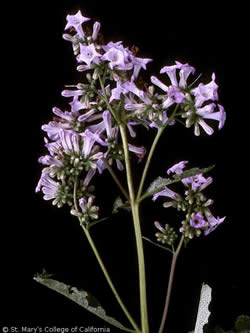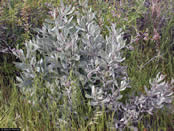Plant of the Week
 Eriodictyon sp. range map. USDA PLANTS Database.
Eriodictyon sp. range map. USDA PLANTS Database.
 Eriodictyon. Note the backs of the leaves (the “woolly net”) and the trumpet-shaped flowers. Photo by Julie K. Nelson, Shasta-Trinity Forest Botanist.
Eriodictyon. Note the backs of the leaves (the “woolly net”) and the trumpet-shaped flowers. Photo by Julie K. Nelson, Shasta-Trinity Forest Botanist.
 California yerba santa (Eriodictyon californicum). Photo by Brother Alfred Brousseau © 1995 Saint Mary's College of California.
California yerba santa (Eriodictyon californicum). Photo by Brother Alfred Brousseau © 1995 Saint Mary's College of California.
Yerba Santa (Eriodictyon sp. Benth.)
By Forest Jay Gauna, Modoc National Forest
Yerba santa is Spanish for “holy weed” or “holy herb.” The three most commonly seen and used species are E. californicum, E. trichocalyx, and E. angustifolium, for northern, southwestern, and eastern California respectively. This genus belongs in the Hydrophyllaceae, or Waterleaf family: this family is known for its beautiful flowers (exempli gratia, baby blue-eyes and fivespot). With taxonomic changes, this family may soon be subsumed into the Boraginaceae, or Borage family, another family well known for colorful flower displays: forget-me-nots, bluebells, and Cryptantha belong to this family. Other species of this genus (E. altissimum and E. capitatum) are protected rare species.
Eriodictyon is a Greek compound word meaning “woolly net,” referring to the fuzzy underside of the leaves. The leaves are tough and leathery, simple, long (3 to 4 inches), and slender (lanceolate), often sticky with resin, with alternate arrangement along the stem. The flowers are white to lavender or purple, and shaped somewhat like little trumpets. The plant itself is about 3 to 4 feet tall. It has been recommended as a landscape plant in appropriate areas, especially in areas suffering from erosion; however, it is competitive and may invade more established gardens.
The Spanish name applied to this plant comes from its famous use as a potent medicinal herb in native California, and its use was quickly adopted. Today, herbal extracts of Yerba Santa can be found in herbal medicine stores. Native Californians used its leaves in the form of a tea, with which they treated respiratory sicknesses, colds, and stomachaches (as well as simply made a cup of tea). A hot, potent extract can be applied hot to a poison oak rash to quicken healing. A poultice of leaves may be applied to flesh wounds, sore muscles, above bone fractures, and where rheumatism strikes. It was also used as a smoke plant, which was said to help those with asthma. In addition to smoking, the leaves can be chewed upon for pleasure.
Apparently, bees who visit the flowers of this plant “make a deliciously spicy amber honey.”





